
Original Link: https://www.anandtech.com/show/253
| So you've got a $10 bill in your wallet, and you walk into a store looking to buy a T-shirt. An eager salesman approaches you and directs you towards their latest collection of $90 dress shirts, now when all you happen to have in your wallet is that $10 bill, the knowledge your new found sales friend is not helping you at all by introducing you to the latest in fashion for $90. This same scenario can be seen duplicated among video card manufacturers in the industry, just as the example of the man looking for a $10 shirt and being pointed in the direction of $90 fashion, most gamers on a budget surfing around for a low-cost 3D solution are being introduced to the latest candidates for the Voodoo2 or Voodoo3 killers at the "low price" of $259.99. | 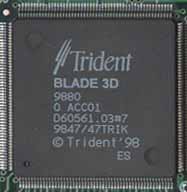 |
| A low-cost video solution at a price that is already twice your allocated budget doesn't really help you all that much, and knowing how fast the card is doesn't detract from the fact that it's still out of your price range. | |
It makes very little sense for all of these large manufacturers such as Matrox and nVidia to leave the low-cost video market in the dust, if anything, they should be concentrating on the low-cost market even more than the high performance market. As we've all learned from Intel's incredible success with the sub-$1000 PC campaign and the Intel Celeron processor, cheaper sells, and as far as the majority of video card manufacturers are concerned, they just haven't been selling.
On the low end of things, there have been a few contributors to the sub-$1000 PC campaign from video card manufacturers, one of the most popular being a company called Trident. Typically associated with the word "crap" among gamers, Trident has never truly had a competitive product on the market, and their presence in the 3D driven world of gaming is just about as prominent as that "friend" of yours that never seems to get invited to any parties. At last year's Fall Comdex, Trident's booth held the first eye catching demonstration this reviewer has seen from the company in years: a Trident video card running a game at a pleasing frame rate with a level of image quality that rivals some of the industry's bad boys. Trident had a product so eye-catching in fact, that VIA chose them, out of all of the possible manufacturers, to include this "revolutionary" (at least for Trident) product as the integrated video core on their low-cost MVP4 chipset, and as AnandTech reported, the MVP4 looks like an instant hit for the sub-$1000 market. What on earth would cause a company like VIA, already struggling to balance the weight of the Super7 market on their shoulders, to pursue Trident as a partner in such a delicate venture? Trident must have something special on their hands, but what? Let's find out as AnandTech takes a look at the barely publicized Blade 3D from Trident, and let's see if we can develop a new word to associate with the name Trident.
Cutting History with Trident's Sword
What is the Blade 3D? The Blade 3D core is an attempt at a reasonably priced, OpenGL/Direct3D AGP 2X solution (AGP - can't leave home without it) that offers DVD acceleration for the sub-$1000 PC market, without providing those who purchase the chipset at a loss of performance. The goal of the Blade 3D, just as virtually any other product that enters this section of the market, is to provide the low-end market with a high-end performer. Unfortunately, with the history of Trident backing them up, the Blade 3D seemed to be doomed from the start. Trident has never had too much success in developing quality products that offered a low-cost and high performance at the same time, the Blade 3D's name is reminiscent of Trident's earlier failures, the Blaze 3D which did very little than provide the ugliest picture of 3D acceleration that $20 could buy.
For those users that aren't familiar with Trident's products, chances are that you've run into a Trident video card or chipset at one point or another. The classic roaming grounds for most of Trident's past video solutions have been on the shelves of your local PC hardware repair and configuration shops, usually bearing generic product names such as "PCI Graphics Card" or "High Speed AGP Accelerator." Their video cards usually boast poor driver support, horrid performance, but an unbeatable price, usually rivaling the costs of going out to lunch and grabbing doughnuts afterwards which was why Trident's products were so popular among users that were on a budget. Following the old maxim, you get what you pay for, it would have made more sense for Trident to feature that logo on the boxes of their video cards prior to the release of the Blade 3D.
What makes the Blade 3D digress from Trident's history? The nature of the product. Instead of producing a solution that's intended to be a cheap space filler on your motherboard, the Blade 3D actually took a little more than a low cost into consideration. The Blade 3D concentrated on performance, image quality, as well as now standard features such as hardware assisted DVD acceleration for low-end systems, this is all in addition to keeping a low price tag.
The 0.25-micron Blade 3D core, on paper, allows for a maximum fill rate of 110 million pixels per second, and a peak processing rate of 2.5 million triangles per second all at its default 120MHz memory clock speed. The fill rate is definitely a tremendous claim made by Trident, and the peak processing power is about two and a half times lower than nVidia's flagship TNT chipset which seems to dominate the high end of the gaming market. The specifications are definitely present to allow for the Blade 3D to remain somewhat competitive with the rest of the 3D gaming market while keeping costs low. As you would be able to expect, the Blade 3D is nothing more than your run-of-the-mill 3D core, offering only single pass single texturing and a 16-bit Z-buffer. Allowing for rendering in up to 32-bit color, the Blade 3D is ready for the future of gaming and produces vibrant images for even the most critical of eyes to enjoy. Unlike previous attempts at gaming solutions by Trident, the Blade 3D is definitely a quality-oriented product if there ever was one from the company, and when AnandTech fired up the sample Trident supplied for testing a quick deviation from the standard "el-cheapo Trident experience" was found.
Installation
The board AnandTech received was an average length AGP adapter that featured both VGA and RCA/S-Video outputs, unfortunately the drivers AnandTech received with the board did not enable the TV-Output. The first experience AnandTech had with the Blade 3D was on the VIA MVP4 chipset, which featured the Blade 3D core as the primary video device physically integrated into the North Bridge of the chipset, so the Blade 3D was not a newcomer to the AnandTech testing lab. Needless to say, as experienced the first time around, the Blade 3D installed without a hitch on the Windows 98 test system. Before physically installing the card, AnandTech took a quick look at the Blade 3D board from Trident.
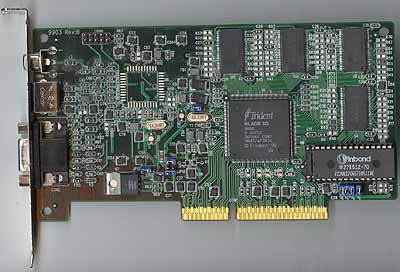
The PloTech manufactured PCB was bare on the backside and covered with resistors and filters on the front side, surrounding the 4 - 2MB Samsung SDRAM memory chips and the Blade 3D processor itself. An unusual presence on the Blade 3D were the numerous configurable although undocumented jumpers on the board, however AnandTech received no documentation on the function of the jumpers and therefore assumed that they would not be present on the final release boards that should begin shipping shortly.
Windows 98 detected the Trident board, as expected, as a Standard VGA adapter and after a quick reboot AnandTech was able to pop in the supplied driver's CD that allowed for a fairly simple setup and configuration process. Using Trident's Automatic Install option, the utility installed the Trident drivers, enabled the AGP GART functions, installed DirectX 6.0 and then rebooted the system on its own after completion. The ease of use of the drivers and the simplicity of the installation is definitely something to be fond of from a "low-cost" solution. In most cases "low-cost" solutions usually mean trouble for compatibility and drivers but in the case of the Blade 3D, the installation on both Slot-1 and Super7 test systems went without even a single hiccup.
For the purpose of benchmarking, Trident included an Alpha version of their OpenGL ICD on the driver's CD that was shipped with the Blade 3D. The OpenGL driver installed just as easily and produced excellent performance (relatively speaking) considering it is only an Alpha release of the driver. It's also interesting to note that Trident managed to provide AnandTech with a functional OpenGL ICD in the package of the Blade 3D board while Matrox, a much larger and well respected company, has failed to release anything other than a Beta OpenGL ICD for their G200 in the 6+ months the G200 has been in the eyes of the media. Maybe it is true that big things are often found in small packages.
The Blade 3D drivers were considerably weak in the ability to tweak settings such as memory/cpu clock, and features such as v-sync were also left out of the relatively barren additions to Windows 98's display control panel. Other than a basic color configuration utility, the Blade 3D left no distinct mark other than its name under the Adapter Settings, a slight regression back to the days of "you get what you pay for." The drivers supplied with the Blade 3D sample, once again, did not contain any TV-Out/DVD acceleration support, which is something you can look forward to in the final release of the Blade 3D drivers.
The Test
The AnandTech Test System Configuration was as follows:
- Intel Pentium II 400
- ABIT BH6 Pentium II BX Motherboard
- 64MB PC100 SDRAM
- Western Digital Caviar AC35100 - UltraATA
- Matrox Millennium G200 AGP Video Card (8MB)
- Canopus Pure3D-2 Voodoo2 (12MB)
All Winstone tests were run at 1024 x 768 x 32 bit color, all gaming performance tests were run at 800 x 600 x 16 bit color. 3DNow! support was enabled when applicable.
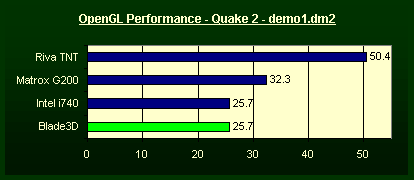
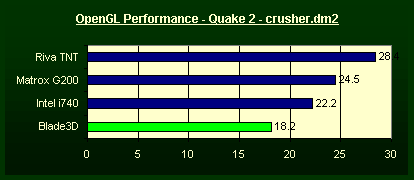
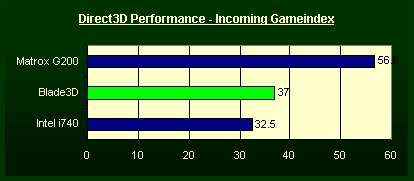
By using a Pentium II 400 as the test bed AnandTech eliminated any CPU bottlenecks as the factors that could affect performance (CPU scaling will be discussed later), and the Trident Blade 3D managed to hover at a playable frame rate of 25 fps under Quake 2, and 37 fps under the Direct3D based Incoming. In all tests, the Blade 3D remained quite competitive in comparison to the i740, while keeping such advantages as full Super7 compatibility (for Super7 performance consult the MVP4 review) and support for hardware DVD acceleration.
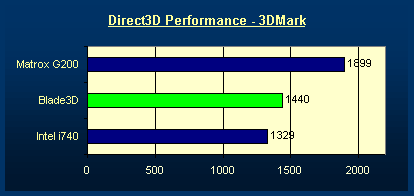
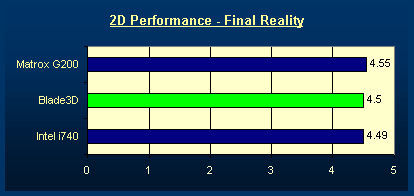
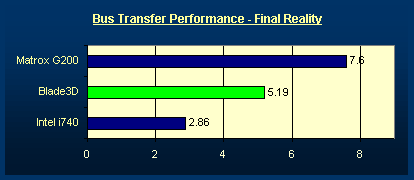
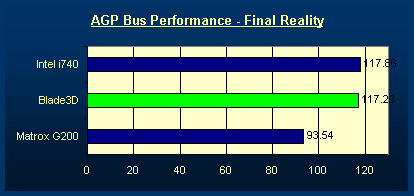
The synthetic benchmarks show clear superiority of the Blade 3D in comparison to the Intel i740, and in the case of the AGP implementation, the Blade 3D even has a more efficient implementation of the AGP 2X specification than the Matrox G200. The 2D and Direct3D performance of the Matrox G200 still holds the clear lead over the much cheaper Blade 3D, however if you consider that the price of the G200 is about 3 to 4 times as much as the Blade 3D, for someone that isn't looking for the absolute best in performance the Blade 3D proves itself to be of an excellent overall value.
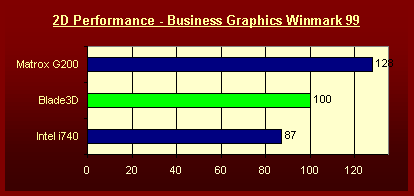

The 2D performance of the Blade 3D, as with Trident's previous ventures, is highly competitive, offering a clear advantage over the i740 while obviously slower than the Matrox G200. There's no question about it that Trident has come a long way since their days of lack luster video products with the Blade 3D.
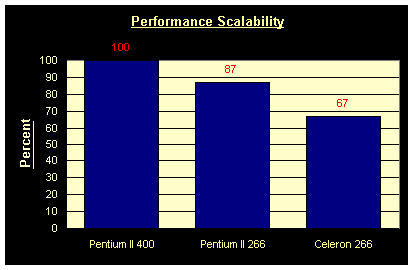
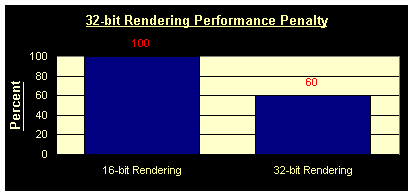
Image Quality Comparison
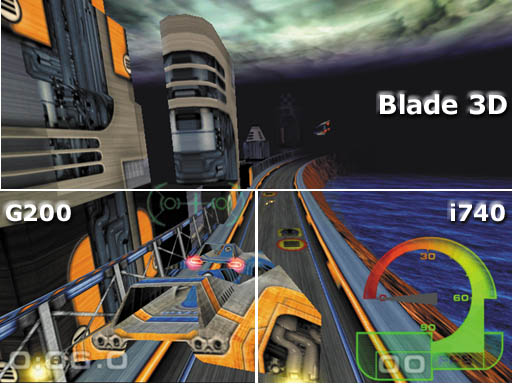
Here you have a single frame from 3DMark, split between the three chipsets compared here, and as you can tell, the image quality is almost indiscernible between the Blade 3D and the more expensive G200. The i740 shares the Blade 3D's outstanding image quality, and it seems like Trident finally got their act together focusing on quality as well as price with this release.
The 2D image quality at higher resolutions and refresh rates (1280x1024 @ 75Hz+) of the Blade 3D is truly impressive, offering a higher image quality than most TNT video cards at these resolutions/refresh rates. While the Blade 3D still does not come close to the incredible 2D image quality Matrox and Number 9 have been able to bring to the market, the Blade 3D's clear and well filtered 2D output, courtesy of the Blade 3D's integrated RAMDAC and high quality filters between the Blade 3D core and the VGA output.
Conclusion
With the price of cards based on Intel's i740 going for around $40, the Blade 3D becomes a viable option only when priced at a reasonable level. As a consumer, if you can't find the Blade 3D for a price lower than $70 then it is definitely not worth the buy as most Banshee cards can be bought for around that price after rebate. The Blade 3D is a promising product from Trident, truly the first in the history of the company. The Blade 3D's combination of outstanding image quality, decent performance, and hopefully, a low cost (the Blade 3D core will be available for $17 in lots of 10,000) combine to make the Blade 3D an excellent addition to a low-cost system. It's not a Voodoo3, and it's not going to provide you with hundreds of frames per second under the latest games, however what the Trident Blade 3D happens to be, is best put by citing Trident's own philosophy, providing "Digital Media for the Masses."







